Southern
Pacific
9010
Carl-Peter Zander
KM Representative in the USA: 1963-1968
The German Connection.
When the SP Krauss-Maffei story is told, mention is often made of the German technical personnel who accompanied the locomotives, working side-by-side with American railroaders to keep them running. But until recently, American KM students have not heard or read much about the overseas perspective.
The SP 9010 effort has been fortunate to have attracted the interest of several of these gentlemen and their families. In June of 2009 we received this cordial note from one of the prominent former members of the Stateside KM team:
"I just came to your website and I am very much impressed about the professional layout, but even more (by) what I can see and read. I would like to introduce myself: Carl-Peter Zander; I am a retired engineer of Krauss-Maffei, and I worked for more than six years on the diesel-hydraulics.
"In October 1963, I replaced (a KM colleague) at the D&RGW in Denver. When these locomotives were sold to SP, I moved to Roseville and was present during the introduction of the new units."
In the summer of 1964, Peter returned to Munich, where he was responsible for ML4000 technical support at KM. He returned to Roseville in November of 1965, to take over as the Krauss-Maffei representative, where he remained until SP cancelled the program. Before he left the U.S., Peter was a first-hand witness to the scrapping of the locomotives he had introduced only a few years before.
How many Germans were there in all?
Mention has often been made of a 'number' of German technicians and Factory reps who took residence in the Roseville area. Peter was able to enlighten us about the actual numbers:
"The prototypes were delivered to D&RGW Denver and SP Roseville in Oct. 1961. At both places a service team was garrisoned, consisting of an engineer as team leader and one each technician from KM, Maybach and Voith.
"Technical problems occurred, thus additional technicians from KM and Maybach were sent out. Some stayed for a short time only, some for a longer period of some months.
"In January 1964, D&RGW sold their locos to SP, and the remaining personnel from Denver were transferred to Roseville. When the new 15 locomotives (including SP 9010) arrived at Roseville in March/April 1964, there came the 'personnel peak' at Roseville: 2 engineers of KM, alongside with 4 technicians; 1 engineer of Maybach, with 2 technicians; and finally, 2 Voith experts.
We'll fix that under the warranty, Sir.
Factory warranties applied to the KM product, the Maybach diesel motors, and the Voith transmissions. Peter Zander and the technicians from all three concerns occupied two major roles at the SP and D&RGW; first as service advisors, instructors, and warranty reps; and second as a data-gathering arm - "eyes in the field" -- for the respective factories, who were deeply invested in the success of the program, monitoring operational failures and taking corrective action.
It's significant to note that the so-called 'first-generation' diesel locomotives of the era - the units which had pushed aside steam power - were facing widespread replacement, and all three German industrial firms were quite keen to get a foot in the door of this potentially lucrative assignment.
The 'modernization' of the Final Four.
Peter was instrumental in the Sacramento rebuilding process which guaranteed our SP 9010 a longer life than other siblings. KM proposed a modification program for all the units, and Peter was responsible for the KM side. He worked closely with two of the KM techs, as well as one of the reps from Maybach and one from Voith.
That's Peter in the suit and hardhat, looking towards camera, with the SP's Frank Kurz in the overcoat. Peter continues:
"After some months the personnel was gradually reduced. In mid-1965 one KM technician was hired by SP for supervising mainly the EMDs, but of course the Alcos and KMs as well (he stayed in Roseville for good); the remaining team consisted of 4 people: 2 KM, and 1 Maybach and Voith each. After SP_s decision not to pursue the modification program any longer, the Voith man left in early 1967. End of February,1968 I returned home as the last one.
"For some time the German community was quite numerous, since many experts were accompanied by their wives and children. Three children were born in Roseville, and three men got married there; two to their German fiancees, one to a U.S. lady. This technician gave up his job with his German company and worked for Alco at different places all over the world. One engineer -- after returning home to KM -- somewhat later quit his job and worked for different firms, finally ending up in the U.S. and responsible for large motive power projects worldwide."
Peter's help with 'little mysteries'.
It's been four decades and more since the program ended. But Peter has been enthusiastically able to help us solve a handful of nagging riddles about SP 9010's mechanical past.
Tank patches.
As discussed on this website in the "SP Mods" section, we were curious about the three square welded patches on SP 9010's fuel tank. We didn't see evidence of them when the unit was delivered, but could plainly see them in photos taken late in 1964. Peter recalled:
"Shortly after the delivery there was one locomotive which was always starving on fuel. We tried everything to detect the reason: changed fuel pumps, filters and check valves; nothing was wrong, but the engine did not get enough fuel. Something must have been wrong with the suction line, and therefore holes were cut into the tank. The reason then was evident: accumulated dirt in front of the pipe."
The missing oil bath air cleaners.
On SP 9010, there are four round blanking plates in the inner roof of each Maybach machine compartment. Drawings and photos show oil bath air filters were installed here as a 'secondary' air intake pathway. When and why were they removed? Here is Peter's recollection:
"The removal of the filters was never agreed to by Maybach, but SP insisted to have a certain test period, and removed them from a number (all?) of the locomotives. Actually this was not a risk, since D&RGW did this on their 3 locos which were sold to SP in 1964, and these engines did not show abnormal wear at piston rings or cylinder liners. But of course Maybach objected, and refused to give any warranty to the engines which were running in locos without these filters. Therefore SP could remove them only after expiration of the warranty period."
Anyone who's ever changed the oil in an oil bath air filter will understand both the efficiency when functioning, and the poor performance and mess when dirty. The door-mounted stack filters evidently were enough.
Heat exchangers on the roof.
We also puzzled over the remainders of what appeared to be supplemental rooftop heat exchangers on SP 9010. Little plumbing has survived, and we were unable to determine for which circuit these devices provided additional cooling. Peter's explanation took us on a fascinating path, all the way back to the six 1961 Prototypes:
"The 6 Prototypes were equipped with slow-running big air compressors from Gardner-Denver, which could not be coupled directly to the (fast-running) diesel. To reduce the RPMs, a V-belt drive was used with 6 or 8 belts in parallel. In fact, the tension of the single belts was unequal. Furthermore, the diesels were mounted on rubber pads with relatively low natural frequency, which meant that the engines were shaking quite a bit during starting and stopping. Because of these facts, the V-belts needed maintenance or replacement quite often.
"To solve these problems, the new locos (including SP 9010) were equipped with faster-running smaller air compressors from Westinghouse (German branch). To shorten the time of pumping air, a hydraulic coupling from Voith was used, which regulated the compressor RPMs to the maximum allowed value regardless of whether the main diesel was idling or under full load.
Peter explained the function of the coupling -- and an unforeseen problem:
"When no air needed to be pumped, the oil flow to the coupling was cut off. Unfortunately some of these cutoff valves were a little leaky, thus a small amount of oil could reach the coupling. No malfunction was visible, the compressor was running or standing still as desired, but this little amount of oil in the coupling was coked by the high temperature of the ventilated air.
Peter continues, as the plot (and the oil) thickens:
"The oil supply for the coupling was part of the traction transmission system, thus the small amount of burned oil was washed into the main transmission and finally some bearing failures there occurred. Only by then had the whole problem been detected. After long discussions and different proposals like filtration or different valves, SP decided to disconnect both circuits, feed the compressor couplings by electric pumps from a separate oil reservoir, and install separate oil-air radiators on the rooftop." And we had the answer to our mystery! But which locomotives received these coolers? Photo evidence shows all four of the 'modernized' units (including SP 9010) - but only one other unmodified unit, SP 9109. We asked Peter why that might have been (we have a lot of questions)...
He replied: "When the modification program was started, it was still under discussion which way to go with the compressor coupling. Since 9109 had such a transmission failure in February of 1966, this one was picked to try this arrangement. Successful tests with electric filling pumps occurred in May." And the supplemental exchangers were evidently adopted for the next chapter in SP 9010's life...
The 1966-67 'modernization' program.
We wondered why the 'Final Four' came to be chosen; why our 9010 (then numbered 9113) was selected for this life-extending honor. (The four Series units selected for KM-supervised rebuilding were 9107, 9113, 9116, and 9120.)
But why these particular units? And why only four? Again, Peter provided the answer:
"In November, 1965, it was agreed between SP and KM to start a modification program for all 15 (Series) locos. Among the (modifications) list was a general overhaul of the diesel engines. SP decided to pick the very first loco with a major engine failure, one which needed to be exchanged at Sacramento shops, as the first one to be modified."
SP 9120 was the first engine failure to come in, and thus was the first rebuild candidate. Peter explained that the next loco selected had to fit Sacramento's capacity. That meant that while one locomotive was being rebuilt, another could have an engine exchanged on the shop track alongside. (That's Peter on the gangway of freshly-painted 9120, on the Sacramento Shops 'firing line'. It sits next to 9108, shown stripped to the frame in the first photo.)
SP 9010 (as 9113) was the next candidate 'up'. But the entire program was halted before all 15 units could be rebuilt.
On the 'firing line'.
Peter sent a picture of himself standing on the platform of SP 9107, while the unit was under test. Both front hood doors were ajar, and heavy hoses played out to the ground from the nearside door. Peter let us know exactly what was going on:
"This picture was taken mid-September 1966 after modification work on 9107 had been finished, and the locomotive underwent a load test at the firing line at Sacramento shops. The diesel engines were supplying full power into the Voith transmissions , but the loco was fully braked.
"This was physically the same as starting a too-heavy train. The cooling system was not designed to meet such service with 100% loss of energy for a longer period than some minutes, therefore an external heat exchanger had to be used, and the two hoses are the feeding and return lines for the transmission oil."
South of the border... a long way South.
After returning to Munich at the termination of the USA program, Peter's work with the 'Series' ML4000 was not over!
"I remember these locos very well. In 1968 I got a promotion to be head of the test department, where we made trials with the second CVRD Series. In 1978 I discussed with CVRD in Rio a possible rehabilitation program, which was very much favoured by Maybach because of the possible need for lots of spare parts.
"Actually, no KM or Voith parts would have been needed, so we refrained from this program, for which CVRD asked for the free manpower support of experts."
When negotiations fell through with Maybach, only two of the units were rebuilt by the CVRD's own shops. And like the SP a decade earlier, no further units would be rebuilt. Soon, dead lines formed in Brazil -- in eerie similarity to the dead lines in Roseville.
Summing up the 'experiment'.
So were the ML4000s a total failure? Depends on how you assess the complete results. Could the KMs in fact be considered a 'conditional success' in the field of motive power advancement?
Here's Peter's summation:
"Only by the appearance of (the 'foreign' KM product) in their home market were GM, GE and Alco alerted to design engines as powerful.
"But KM tried to conquer a new market with inadequate components, which could bear the European load profiles easily, but not the U.S. requirements with uninterrupted full load for hours. Exception was the hydraulic transmission, which still is widely used all over the world, even under bad maintenance conditions, because it hardly needs any maintenance. But the experience at the SP Lines hampered the selling of high power transmissions for a substantial period."
A 'moving' history -- the movies of Peter Zander.
Peter's contribution to the SP 9010 project continues, with his gracious and thorough responses to our most trivial technical questions. But he's offered more than just information!
Peter Zander and his Roseville KM colleague Otto Baumgartner were prolific photographers during their time in the United States. We've already shared some of Otto Baumgartner's best. Now, thanks to Peter's generosity and interest in the 9010 project, we can also share some of Peter's 8mm movies.
His camera captured everything from the service racks at Roseville, to the PLA passenger excursion behind SP 9120 (which operated through Niles Canyon), to the sad and melancholy end at the scrap yard of Associated Metals in Sacramento.
Sampler.
Below is a sampler of frame captures from Peter's Super 8 originals, in greatly reduced resolution. Also here are Peter's notes on his movie efforts:
"This film is more a private remembrance than a technical documentation. It starts with a visit of Otto Baumgartner and me at the Nut Tree alongside the highway from Sacramento to San Francisco.
"Then, several locomotives are coming from and going into the Roseville shunting yard. A few shots have been taken at the service track, where fuel and sand had to be replaced.
"After then, Otto and I took some shots at the mainline to Donner Pass, near the bridge at Colfax. Next is the trip of the 9120 towing a passenger train through the Sacramento Valley and making a photo stop at Sacramento Station.
"Finally, some locos are to be seen at the Sacramento scrapyard, and some cars filled with scrap material, including unused spare parts like engine valves. Also shown is a diagram showing the percentage of unavailability of the fleet over the years. (I am afraid it is hard to read)"
Peter's films of the demoralizing end to an extraordinary effort are haunting. It had to have been profoundly dispiriting to the men and their families who'd nursed these troubled locomotives from the shop floor to premature retirement.
But his films of KM locomotives in their most successful element -- trotting long strings of SP tonnage up and down the Valley as but a single unit - are a positive, happy counterpoint.
Here's a link to a 'trailer' we created for Peter's movies, which shows the movie's highlights (and sadly, the lowlights):
We're editing and digitizing the full movies now, and will post them here soon! Meanwhile, as Peter continues to offer us a wealth of technical information and some sterling recollections, he says: "I am very much interested in the progress of your program."
And needless for us to say, we have been delighted to have Peter Zander on the crew!
Return To Main Page
Carl-Peter Zander
KM Representative in the USA: 1963-1968
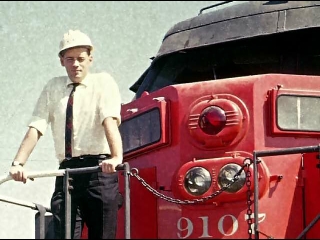 |
The German Connection.
When the SP Krauss-Maffei story is told, mention is often made of the German technical personnel who accompanied the locomotives, working side-by-side with American railroaders to keep them running. But until recently, American KM students have not heard or read much about the overseas perspective.
The SP 9010 effort has been fortunate to have attracted the interest of several of these gentlemen and their families. In June of 2009 we received this cordial note from one of the prominent former members of the Stateside KM team:
"I just came to your website and I am very much impressed about the professional layout, but even more (by) what I can see and read. I would like to introduce myself: Carl-Peter Zander; I am a retired engineer of Krauss-Maffei, and I worked for more than six years on the diesel-hydraulics.
"In October 1963, I replaced (a KM colleague) at the D&RGW in Denver. When these locomotives were sold to SP, I moved to Roseville and was present during the introduction of the new units."
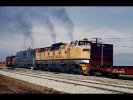 John
Signor Collection
|
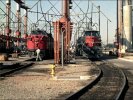 Richard
Oed Photo
|
In the summer of 1964, Peter returned to Munich, where he was responsible for ML4000 technical support at KM. He returned to Roseville in November of 1965, to take over as the Krauss-Maffei representative, where he remained until SP cancelled the program. Before he left the U.S., Peter was a first-hand witness to the scrapping of the locomotives he had introduced only a few years before.
How many Germans were there in all?
Mention has often been made of a 'number' of German technicians and Factory reps who took residence in the Roseville area. Peter was able to enlighten us about the actual numbers:
"The prototypes were delivered to D&RGW Denver and SP Roseville in Oct. 1961. At both places a service team was garrisoned, consisting of an engineer as team leader and one each technician from KM, Maybach and Voith.
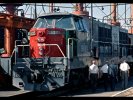 Richard
Oed Photo
|
"Technical problems occurred, thus additional technicians from KM and Maybach were sent out. Some stayed for a short time only, some for a longer period of some months.
"In January 1964, D&RGW sold their locos to SP, and the remaining personnel from Denver were transferred to Roseville. When the new 15 locomotives (including SP 9010) arrived at Roseville in March/April 1964, there came the 'personnel peak' at Roseville: 2 engineers of KM, alongside with 4 technicians; 1 engineer of Maybach, with 2 technicians; and finally, 2 Voith experts.
We'll fix that under the warranty, Sir.
Factory warranties applied to the KM product, the Maybach diesel motors, and the Voith transmissions. Peter Zander and the technicians from all three concerns occupied two major roles at the SP and D&RGW; first as service advisors, instructors, and warranty reps; and second as a data-gathering arm - "eyes in the field" -- for the respective factories, who were deeply invested in the success of the program, monitoring operational failures and taking corrective action.
It's significant to note that the so-called 'first-generation' diesel locomotives of the era - the units which had pushed aside steam power - were facing widespread replacement, and all three German industrial firms were quite keen to get a foot in the door of this potentially lucrative assignment.
The 'modernization' of the Final Four.
Peter was instrumental in the Sacramento rebuilding process which guaranteed our SP 9010 a longer life than other siblings. KM proposed a modification program for all the units, and Peter was responsible for the KM side. He worked closely with two of the KM techs, as well as one of the reps from Maybach and one from Voith.
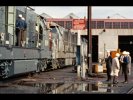 Richard
G. Oed Collection
|
That's Peter in the suit and hardhat, looking towards camera, with the SP's Frank Kurz in the overcoat. Peter continues:
"After some months the personnel was gradually reduced. In mid-1965 one KM technician was hired by SP for supervising mainly the EMDs, but of course the Alcos and KMs as well (he stayed in Roseville for good); the remaining team consisted of 4 people: 2 KM, and 1 Maybach and Voith each. After SP_s decision not to pursue the modification program any longer, the Voith man left in early 1967. End of February,1968 I returned home as the last one.
"For some time the German community was quite numerous, since many experts were accompanied by their wives and children. Three children were born in Roseville, and three men got married there; two to their German fiancees, one to a U.S. lady. This technician gave up his job with his German company and worked for Alco at different places all over the world. One engineer -- after returning home to KM -- somewhat later quit his job and worked for different firms, finally ending up in the U.S. and responsible for large motive power projects worldwide."
Peter's help with 'little mysteries'.
It's been four decades and more since the program ended. But Peter has been enthusiastically able to help us solve a handful of nagging riddles about SP 9010's mechanical past.
Tank patches.
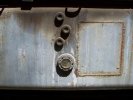 Howard
P. Wise Photo
|
As discussed on this website in the "SP Mods" section, we were curious about the three square welded patches on SP 9010's fuel tank. We didn't see evidence of them when the unit was delivered, but could plainly see them in photos taken late in 1964. Peter recalled:
"Shortly after the delivery there was one locomotive which was always starving on fuel. We tried everything to detect the reason: changed fuel pumps, filters and check valves; nothing was wrong, but the engine did not get enough fuel. Something must have been wrong with the suction line, and therefore holes were cut into the tank. The reason then was evident: accumulated dirt in front of the pipe."
The missing oil bath air cleaners.
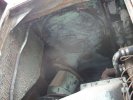 Howard
P. Wise Photo
|
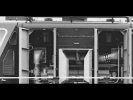 Krauss-Maffei
AG
|
On SP 9010, there are four round blanking plates in the inner roof of each Maybach machine compartment. Drawings and photos show oil bath air filters were installed here as a 'secondary' air intake pathway. When and why were they removed? Here is Peter's recollection:
"The removal of the filters was never agreed to by Maybach, but SP insisted to have a certain test period, and removed them from a number (all?) of the locomotives. Actually this was not a risk, since D&RGW did this on their 3 locos which were sold to SP in 1964, and these engines did not show abnormal wear at piston rings or cylinder liners. But of course Maybach objected, and refused to give any warranty to the engines which were running in locos without these filters. Therefore SP could remove them only after expiration of the warranty period."
Anyone who's ever changed the oil in an oil bath air filter will understand both the efficiency when functioning, and the poor performance and mess when dirty. The door-mounted stack filters evidently were enough.
Heat exchangers on the roof.
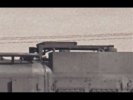 Robert
L. Hogan Photo
|
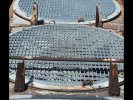 Howard
P. Wise Photo
|
We also puzzled over the remainders of what appeared to be supplemental rooftop heat exchangers on SP 9010. Little plumbing has survived, and we were unable to determine for which circuit these devices provided additional cooling. Peter's explanation took us on a fascinating path, all the way back to the six 1961 Prototypes:
"The 6 Prototypes were equipped with slow-running big air compressors from Gardner-Denver, which could not be coupled directly to the (fast-running) diesel. To reduce the RPMs, a V-belt drive was used with 6 or 8 belts in parallel. In fact, the tension of the single belts was unequal. Furthermore, the diesels were mounted on rubber pads with relatively low natural frequency, which meant that the engines were shaking quite a bit during starting and stopping. Because of these facts, the V-belts needed maintenance or replacement quite often.
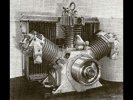 Prototype
Air Compressor
Krauss-Maffei AG |
"To solve these problems, the new locos (including SP 9010) were equipped with faster-running smaller air compressors from Westinghouse (German branch). To shorten the time of pumping air, a hydraulic coupling from Voith was used, which regulated the compressor RPMs to the maximum allowed value regardless of whether the main diesel was idling or under full load.
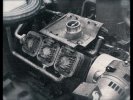 Series
Air Compressor
Krauss-Maffei AG |
Peter explained the function of the coupling -- and an unforeseen problem:
"When no air needed to be pumped, the oil flow to the coupling was cut off. Unfortunately some of these cutoff valves were a little leaky, thus a small amount of oil could reach the coupling. No malfunction was visible, the compressor was running or standing still as desired, but this little amount of oil in the coupling was coked by the high temperature of the ventilated air.
Peter continues, as the plot (and the oil) thickens:
"The oil supply for the coupling was part of the traction transmission system, thus the small amount of burned oil was washed into the main transmission and finally some bearing failures there occurred. Only by then had the whole problem been detected. After long discussions and different proposals like filtration or different valves, SP decided to disconnect both circuits, feed the compressor couplings by electric pumps from a separate oil reservoir, and install separate oil-air radiators on the rooftop." And we had the answer to our mystery! But which locomotives received these coolers? Photo evidence shows all four of the 'modernized' units (including SP 9010) - but only one other unmodified unit, SP 9109. We asked Peter why that might have been (we have a lot of questions)...
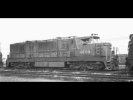 Vic
Reyna Photo
|
He replied: "When the modification program was started, it was still under discussion which way to go with the compressor coupling. Since 9109 had such a transmission failure in February of 1966, this one was picked to try this arrangement. Successful tests with electric filling pumps occurred in May." And the supplemental exchangers were evidently adopted for the next chapter in SP 9010's life...
The 1966-67 'modernization' program.
We wondered why the 'Final Four' came to be chosen; why our 9010 (then numbered 9113) was selected for this life-extending honor. (The four Series units selected for KM-supervised rebuilding were 9107, 9113, 9116, and 9120.)
But why these particular units? And why only four? Again, Peter provided the answer:
"In November, 1965, it was agreed between SP and KM to start a modification program for all 15 (Series) locos. Among the (modifications) list was a general overhaul of the diesel engines. SP decided to pick the very first loco with a major engine failure, one which needed to be exchanged at Sacramento shops, as the first one to be modified."
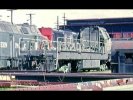 Otto
Baumgartner Photo
|
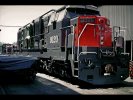 Otto
Baumgartner Photo
|
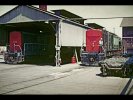 Otto
Baumgartner Photo
|
SP 9120 was the first engine failure to come in, and thus was the first rebuild candidate. Peter explained that the next loco selected had to fit Sacramento's capacity. That meant that while one locomotive was being rebuilt, another could have an engine exchanged on the shop track alongside. (That's Peter on the gangway of freshly-painted 9120, on the Sacramento Shops 'firing line'. It sits next to 9108, shown stripped to the frame in the first photo.)
SP 9010 (as 9113) was the next candidate 'up'. But the entire program was halted before all 15 units could be rebuilt.
On the 'firing line'.
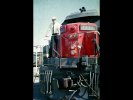 Carl-Peter
Zander Collection
|
Peter sent a picture of himself standing on the platform of SP 9107, while the unit was under test. Both front hood doors were ajar, and heavy hoses played out to the ground from the nearside door. Peter let us know exactly what was going on:
"This picture was taken mid-September 1966 after modification work on 9107 had been finished, and the locomotive underwent a load test at the firing line at Sacramento shops. The diesel engines were supplying full power into the Voith transmissions , but the loco was fully braked.
"This was physically the same as starting a too-heavy train. The cooling system was not designed to meet such service with 100% loss of energy for a longer period than some minutes, therefore an external heat exchanger had to be used, and the two hoses are the feeding and return lines for the transmission oil."
South of the border... a long way South.
After returning to Munich at the termination of the USA program, Peter's work with the 'Series' ML4000 was not over!
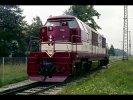 Richard
Oed Photo
|
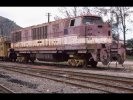 Deane
Motis Photo
|
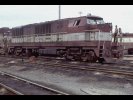 Deane
Motis Collection
|
"I remember these locos very well. In 1968 I got a promotion to be head of the test department, where we made trials with the second CVRD Series. In 1978 I discussed with CVRD in Rio a possible rehabilitation program, which was very much favoured by Maybach because of the possible need for lots of spare parts.
"Actually, no KM or Voith parts would have been needed, so we refrained from this program, for which CVRD asked for the free manpower support of experts."
When negotiations fell through with Maybach, only two of the units were rebuilt by the CVRD's own shops. And like the SP a decade earlier, no further units would be rebuilt. Soon, dead lines formed in Brazil -- in eerie similarity to the dead lines in Roseville.
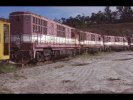 Deane
Motis Photo
|
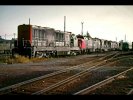 Otto
Baumgartner Photo
|
Summing up the 'experiment'.
So were the ML4000s a total failure? Depends on how you assess the complete results. Could the KMs in fact be considered a 'conditional success' in the field of motive power advancement?
Here's Peter's summation:
"Only by the appearance of (the 'foreign' KM product) in their home market were GM, GE and Alco alerted to design engines as powerful.
"But KM tried to conquer a new market with inadequate components, which could bear the European load profiles easily, but not the U.S. requirements with uninterrupted full load for hours. Exception was the hydraulic transmission, which still is widely used all over the world, even under bad maintenance conditions, because it hardly needs any maintenance. But the experience at the SP Lines hampered the selling of high power transmissions for a substantial period."
A 'moving' history -- the movies of Peter Zander.
Peter's contribution to the SP 9010 project continues, with his gracious and thorough responses to our most trivial technical questions. But he's offered more than just information!
Peter Zander and his Roseville KM colleague Otto Baumgartner were prolific photographers during their time in the United States. We've already shared some of Otto Baumgartner's best. Now, thanks to Peter's generosity and interest in the 9010 project, we can also share some of Peter's 8mm movies.
His camera captured everything from the service racks at Roseville, to the PLA passenger excursion behind SP 9120 (which operated through Niles Canyon), to the sad and melancholy end at the scrap yard of Associated Metals in Sacramento.
Sampler.
Below is a sampler of frame captures from Peter's Super 8 originals, in greatly reduced resolution. Also here are Peter's notes on his movie efforts:
"This film is more a private remembrance than a technical documentation. It starts with a visit of Otto Baumgartner and me at the Nut Tree alongside the highway from Sacramento to San Francisco.
"Then, several locomotives are coming from and going into the Roseville shunting yard. A few shots have been taken at the service track, where fuel and sand had to be replaced.
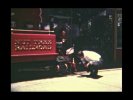 |
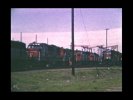 |
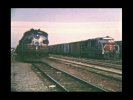 |
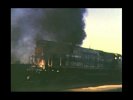 |
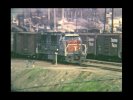 |
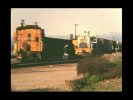 |
"After then, Otto and I took some shots at the mainline to Donner Pass, near the bridge at Colfax. Next is the trip of the 9120 towing a passenger train through the Sacramento Valley and making a photo stop at Sacramento Station.
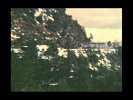 |
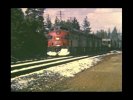 |
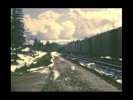 |
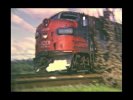 |
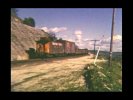 |
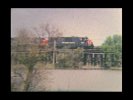 |
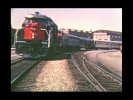 |
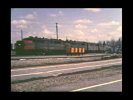 |
"Finally, some locos are to be seen at the Sacramento scrapyard, and some cars filled with scrap material, including unused spare parts like engine valves. Also shown is a diagram showing the percentage of unavailability of the fleet over the years. (I am afraid it is hard to read)"
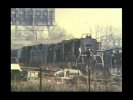 |
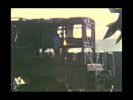 |
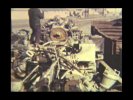 |
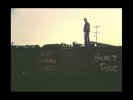 |
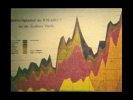 |
Peter's films of the demoralizing end to an extraordinary effort are haunting. It had to have been profoundly dispiriting to the men and their families who'd nursed these troubled locomotives from the shop floor to premature retirement.
But his films of KM locomotives in their most successful element -- trotting long strings of SP tonnage up and down the Valley as but a single unit - are a positive, happy counterpoint.
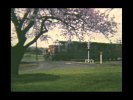 |
Here's a link to a 'trailer' we created for Peter's movies, which shows the movie's highlights (and sadly, the lowlights):
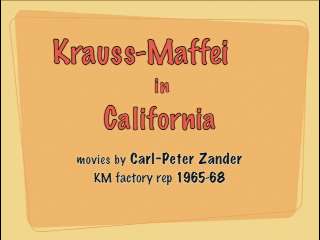 |
We're editing and digitizing the full movies now, and will post them here soon! Meanwhile, as Peter continues to offer us a wealth of technical information and some sterling recollections, he says: "I am very much interested in the progress of your program."
And needless for us to say, we have been delighted to have Peter Zander on the crew!
Return To Main Page